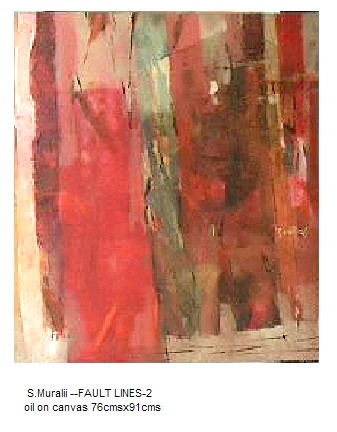Conversations with Children by S. Murali. Puducherry Co-op Book Society, 9, Jeevantham Street, Ashok Nagar, Pondicherry 605008. 2005. 38pp. Paperback. Rs.60.00. ISBN 81-87299-10-06.
Review by Prof Shyamala Narayan, JIWE 14.3.2007
S. Murali is a painter of repute, and a literary critic who has specialised in Indian literary theory and aesthetics. He is with the Department of English, Pondicherry University. Conversations with Children, his second collection of poems, lives up to the promise of his first collection, Night Heron (1998); however, unlike Night Heron, it has no illustrations.
S. Murali is a painter of repute, and a literary critic who has specialised in Indian literary theory and aesthetics. He is with the Department of English, Pondicherry University. Conversations with Children, his second collection of poems, lives up to the promise of his first collection, Night Heron (1998); however, unlike Night Heron, it has no illustrations.
The twenty-five poems here have a variety of themes -- the title poem deals with the problem of communication, while “My Father and R.K.Narayan” is a moving tribute, mourning both his father and the eminent writer, who “died a few days before R.K.Narayan did.” As in the earlier collection, love of nature is an important theme; “The Bleeding Tree” which laments over deforestation has an allegorical quality about it. Some poems, such as “I Like to let the word fly about”, “There’s no Wisdom in Poetry” and “Afterward” deal with the art and craft of poetry. Some poems are based on the Puranas. There are five poems about Krishna, and his miraculous childhood exploits. There are poems expressing the feelings of Eklavya, Garuda, Krishna, Karna and Kaikeyi. “Amba Upanishad” expresses the anguish of Amba, the princess forcibly brought to Hastinapur by Bhishma to be his brother’s bride; she confesses, “I had not known enough of hate/ Before now, to hate so much . . .” In “I, Bahuka”, the protagonist wonders who he really is, the glorious King Nala, husband of the beautiful Damayanti, or the dark, ugly Bahuka he became when bitten by a serpent. Murali’s poems are characterized by careful craftsmanship. His free verse experiments with a number of stanza forms, such as four-line stanzas and three-line stanzas. Some poems have a refrain, but he avoids rhyme.
The title poem is representative of his work – there is deep thought, a feel for human relationships, closeness to nature, and striking imagery. “Conversations with Children” is a meditation on the way children casually avoid listening to adults and their sermons about “general rules of behaviour”, and “dos and don’ts”. The imagery is concrete, and original:
Like cows in the mid-stream of highway traffic
nonchalant they stand, letting each word
glide by; dodging and ducking, or with a simple
toss of the head disengaging artha from sabda
as simple as peeling bananas.
Waste water cascade.
Most Indians will respond to the unusual image, as the picture of a cow placidly chewing its cud in the middle of the road springs to mind. The next image, of peeling a banana, starts on a new line, to highlight the ease with which unpleasant conversation is side-stepped, for it is considered only “waste water”. Two lines are used as a kind of refrain, occurring thrice in the poem:
Fly away, fly away word –
there’s just not any space for you.
But the poem is not a facile condemnation of the younger generation; it is only after “long years of wandering” that the poet has realized that “Conversation is all”, earlier he was among those who thought that “it’s all conversation”. “Now my children beside me” indicates that it is an older (and wiser) man who is speaking. There is a note of hope as he sits with his children; communication can take the form of responding together to nature, its fury and its beauty:
Now my children beside me, I sit and watch
the slow fading of light in the new monsoon
trees all agog with words, the wind
and lightning; thunder calls across the sky.
So much meaning being tossed about
in the open. Shall we reach out
and clutch? Conversation is all
But they do not understand the importance of conversation, the response to the plea for reaching out and clutching is negative:
and clutch? Conversation is all
empty dispensation of words
a loose cloud over all
And the poem ends with the refrain: Fly away, fly away word –/ there’s just not any space for you.”
One does not know (and the poet probably does not care) how a non-Indian reader would respond to such imagery. Would they slot the cow or the monsoon into the category of the “exotic Other”? Would they be able to understand the reference to “artha from sabda” (and the implied allusion to Kalidasa)? The same questions could be asked about Murali’s poems about figures from Indian mythology. But there is no doubt that these poems are a rewarding experience for the Indian reader; they are thought provoking, and present fresh perspectives on characters like Kaikeyi.--
Shyamala A. Narayan
JIWE 14.3.2007
1
